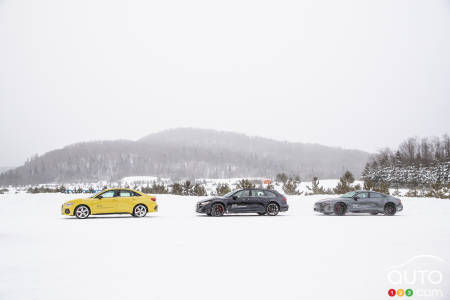Notre-Dame-de-la-Merci, QC - At Audi Canada's invitation, we recently took advantage of a cold, snowy day at the Mécaglisse racetrack north of Montreal in Quebec to hone our skills on the ice and put the company's various Quattro all-wheel drive systems to the test.
Three models to test
Three models were available on site. For the occasions, Audi Canada had sent over no fewer than six Audi RS6 wagons, equipped with a 591-horsepower 4.0-litre V8. There was also the new S3 and its 300 hp under the hood, as well as thee-tron GT RS electric model. The Mechaglisse circuit being entirely icy, all the vehicles were dressed with studded winter tires. We had to be given at least half a chance, after all…
The Quattro systems
The goal of this test day was to understand Audi's Quattro philosophy and systems, via six distinct exercises. From the slalom track to the skid circle to the icy track, all the challenges were there for us to have our little fun with. For each workshop, there were the three models and each driver took turns driving each one. The skid ring was the only place where there were only gasoline-powered models.
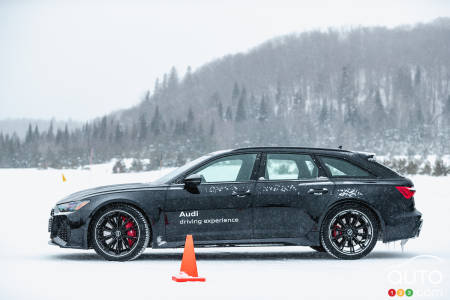
Mastering the Beast
The RS6 is an exceptional machine on the road, but on the ice, it's a different story. You have to be deft with it, because even a little too much throttle and you're bound to spin out.
On this model, the Quattro configuration has a default engine power split that sends 60 percent to the rear wheels and 40 percent to the front. This system is designed to give you the feel of driving a rear-wheel drive car in normal use, but if the rear wheels start to lose traction, the system can instantly divert more power to the front wheels. The response is quick and you can constantly feel the system compensating for the loss of traction.
Of the three models on site, the RS6 was the fastest to adapt to a situation. On the other hand, its weight and sheer power posed a challenge. Once mastered, though, we could handle it well on the skid ring, and the sound of the engine at high revs was an added, chilling bonus.
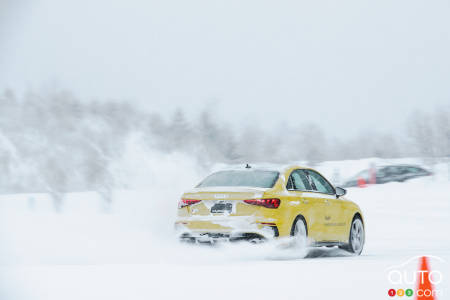
The S3, more compact and agile
The Quattro system on the S3 feeds mainly the front wheels, until they start to lose traction, at which point a multi-plate clutch diverts power to the rear wheels – though those never receive more than 50 percent of the power. There's a pre-load on the rear wheels that keeps the reaction time to a minimum.
On the Mecaglisse circuit, it was the most interesting car to drive because of its compact size and lighter weight, which made it very maneuverable. In the slalom event and on the skid ring, the fun of it left smiles on all the drivers’ faces, plus the sound of the 4-cylinder always makes you want to ask for more.
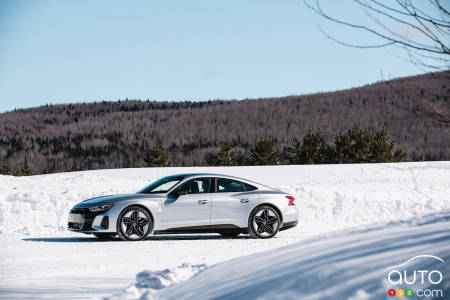
An electric Audi too
The newcomer for many of the media on site was the e-tron GT RS electric sports sedan, which offers the equivalent of 590 hp (637 with the overboost function) and 612 lb-ft of torque.
Since this is an electric vehicle, there’s obviously no mechanical link between the wheels and the motor. Instead, electronic impulses continuously adjust and maintain the ideal torque distribution between the two axles in a fully variable manner, in fractions of a second. This is made possible by a motor on the front axle and two electric motors in a single housing on the rear axle. This means that each axle has two motors, the interaction of which results in the electric Quattro.
A different feel
The connection between the front and rear axles is achieved solely through connected software functions. The electric Quattro system distributes torque between the front and rear axles as needed, from zero to 100 percent. Ice is the best place to see how responsive such a system is. We did find that the electronic and somewhat sanitized feel takes a bit of getting used to.
The system is effective, though, particularly in hoe it disguises the car's 2,250 kg weight, but it's its digitized way of ensuring traction that's a little unsettling at first. The mechanical Quattro is a matter of instinct and the RS6 is predictable. You can feel when a corner is well taken. In the e-tron, you have to rely on the algorithms. The efficiency is very good, but it's a different way to drive.
The different drive modes offer a different mapping, for example emphasizing the rear wheels in dynamic mode. There's even a rear axle differential lock that's integrated into the electronic chassis platform control operations on the RS e-tron GT and optional on the e-tron GT. This feature increases lateral acceleration through targeted torque distribution, improves traction and stability and reduces load-shift reactions, providing very gasoline-like response and handling.
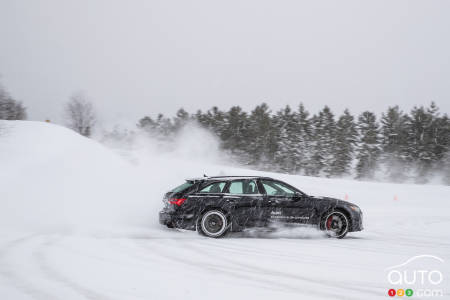
Letting the driver control the elements
For all of the day's exercises, one part of the workshop was done with the electronic driving aids on (except for the skid ring) and the other with them off. Needless to say, the second part was by far the most interesting and the one that taught us the most about the car's real personality.
The gasoline models have the advantage of being more predictable. After rubbing a few snowbanks a little too closely in the first lap, we found the right dosage to apply (which is very tricky on ice) and then we felt we could fully enjoy the car. That’s more difficult with the electric version, because finding the right balance with electronic impulses is just more complicated. However, we have to admit that the e-tron GT RS is very able and capable once you get used to its weight and size.
